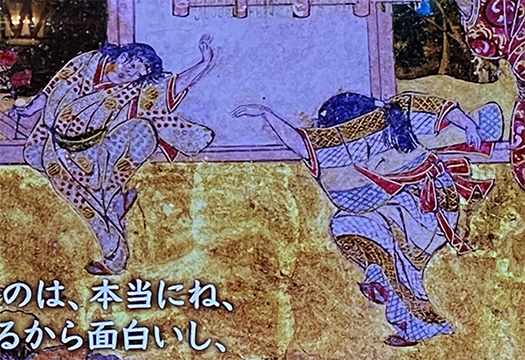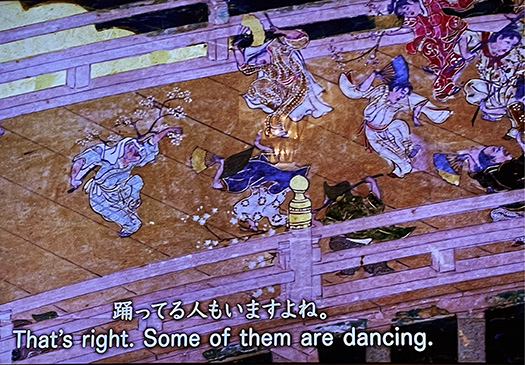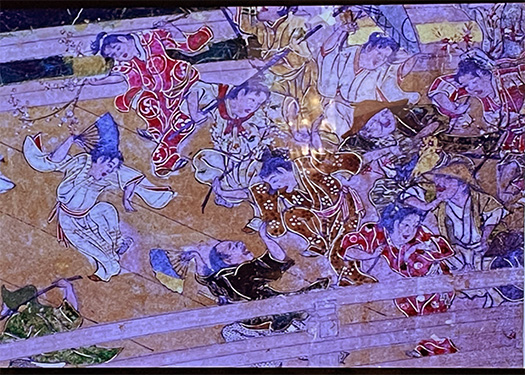


洛中洛外図・岩佐又兵衛作品からの詳細画像から。
現代日本人の大人は街頭で踊ったりすることは稀でしょう。阿波踊りなどのイベントなどでは集団群舞が見られるけれど、ああしたものも一種の「様式化」ルールに基づいてコントロールされている。
江戸幕藩体制社会が国内平和最優先で構築されていったときに、たぶんこういう初源的な日本人の体動感覚は、大きく規制されていったのではないか。
戦国期、豊臣期の雰囲気を色濃く遺しているこの洛中洛外図・岩佐又兵衛作品では、その時代の「ふつうの人びと」の体動感覚が表現されているように思う。「京都の街のにぎわいを表現する」という画業目的から多少の誇張表現はあり得るけれど、まったくの根拠のない表現ではないだろう。
いちばん上の図は京都市中でのさる店舗前で、女性2人が踊りで「客引き」している様子。現代人からすると「これは芸能人のパフォーマンスを頼んだのか」と思えるほど、体の内側からの強烈なリズム感に身を委ねて、全身をその熱気に乗せている様が伝わってくる。
チラシを作って顧客に配布するとか、テレビやyoutubeなどで広告拡散する手段のない時代。店舗側の必死な努力がこういうカタチで結晶していったのだろうか。
その下の図は花見の様子で、先頭の人物はなんとサクラの枝を折ったヤツを方に乗せて、一団を誘導している。あきらかに花見の帰りの様子なのだろうけれど、京都の街並みを象徴するような橋を、まるで舞台のように見立てて、集団群舞をグイグイと「乗せて」いるかのよう。3枚目の図はその花見の一団の様子だけれど、先頭の人物はどうみても年長者であり、一団の統率者とも見える。
そういう社会的役割とおぼしき人物が、このように狂騰群舞を積極的に「仕掛けている」ことになる。 現代人で考えれば、そういった役割の人物は、よくてもニコニコとして一団の後ろに付いている、というのが一般的だろう。万が一、ケンカなどが起こった際には、それを収める役割が重大で、盛り上げるのは、ほかの人物の好きに委ねるというのが一般的。間違っても枝を折って肩掛けするマナー違反はありえないだろう。
さらに言えば、こういう体動感覚には当然ながら「リズム感」音楽性がイメージされている必要があるだろう。祭りでは笛や太鼓などの楽器が、人びとを狂騰させるワケだけれど、京都市中でのこうした群舞ではまさかそういった「楽団」があったとも思われない。踊り狂っているかれら、彼女らは、脳裏の中のある特定の音曲のリズム感に身を委ねていたのだろうか。
そうだとすれば、日本の中世までの人びとにはネイティブに強烈な体内リズム感があったと思える。かれらのパワーに、圧倒されて見惚れている。
English version⬇
Native Japanese sense of dance and body movement
In order to realize the “Taihei” society of the Edo period (1603-1868), the native Japanese “sense of dynamism” must have been strongly restrained. I want to be drawn into the sense of rhythm of unrestrained dancing. …….
From the detailed image of Rakuchu Rakugai-zu, a work by Matabei Iwasa.
It is rare for modern Japanese adults to dance in the streets. Group group dances can be seen at events such as the Awa Odori dance, but even these are controlled by a kind of “stylized” rule.
When the Edo shogunate and feudal system of society was established with the highest priority on domestic peace, this kind of primitive sense of Japanese physical movement was probably greatly restricted.
This work by Iwasa Matabei, Rakuchu-Rakugai-zu, which strongly preserves the atmosphere of the Sengoku and Toyotomi periods, seems to express the sense of physical movement of “ordinary people” of those periods. Although there may be some exaggeration in the expression of the purpose of the work, “to express the liveliness of the city of Kyoto,” I do not think that the expression is completely groundless.
The top image shows two women dancing and “touting” in front of a store in Kyoto. To a modern observer, it might seem as if they were asking for an entertainer’s performance, as if they were giving themselves over to a strong sense of rhythm from within their bodies and letting their whole bodies be carried away by their enthusiasm.
This is an age when there is no way to make flyers and distribute them to customers, or to spread advertisements on TV or Youtube. I wonder if the desperate efforts on the part of the stores crystallized in this form.
The figure below is a scene of a cherry blossom viewing party, and the person at the front is leading the group with a broken cherry blossom branch. The third image shows the group at the cherry blossom viewing party, and the leading figure is clearly an elder and appears to be the leader of the group.
The person in the foreground is clearly an elder and appears to be the leader of the group. In the modern world, such a person would generally follow behind the group with a smile on his face at best. If a fight should break out, it is common for them to play the important role of containing the situation and leave the enlivening to the other members of the group. Even if I am wrong, there would be no breach of etiquette to break a branch and hang it over one’s shoulder.
Furthermore, this kind of sense of physical movement would naturally require a “sense of rhythm” musicality to be imagined. At festivals, flutes, drums, and other musical instruments are used to make people go crazy, but I don’t think there was any such “orchestra” at these group dances in the city of Kyoto. Were they dancing wildly, surrendering themselves to the rhythmic sense of a particular piece of music in their minds?
If so, people in Japan up to the Middle Ages seem to have had a strong sense of rhythm in their bodies. We are overwhelmed by their power and admire them.
Posted on 3月 26th, 2024 by 三木 奎吾
Filed under: 日本社会・文化研究







コメントを投稿
「※誹謗中傷や、悪意のある書き込み、営利目的などのコメントを防ぐために、投稿された全てのコメントは一時的に保留されますのでご了承ください。」
You must be logged in to post a comment.